Vatican Art Story | Location | Opening Hours Tickets | Authorisations
Art Story Sistine Chapel | Raphael | Caravaggio | da Vinci | Giotto | Titian | Veronese | Sculptures | Van Gogh |
Raphael’s School of Athens, Right and Left Part, Vatican in Rome
Raphael “School of Athens”
Fresco (440cm x 770cm) 1509-1510Back to Page 1
Around Plato and Aristotle
Around Plato and Aristotle, Raphael placed two wings of supporters and defenders of the ideas of both.Two wings are arranged in the space of the fresco in the style of a theatrical production.
Socrates is among the men on the left, at the top of the stairs, and is talking in a simple green tunic.
Raphael drew lines from a bust of Socrates that was and still is part of the Vatican collections to represent him.
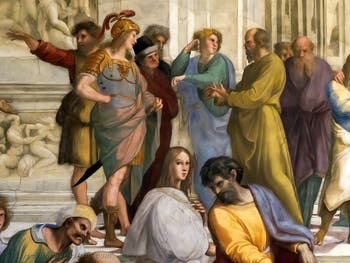
Raphael, School of Athens Socrates is in a lively dialogue with the group of men in front of him, one of them is helmeted with his sword at his side: we think of Callicles, the warrior who refused equality between men based on animal behaviour to affirm that the weakest must be subject to the law of the strongest and most gifted.
Callicles confronts Socrates in Plato’s Gorgias, a dialogue on rhetoric, the speciality taught by the Sophists to succeed in politics.
Raphael perfectly drew the movement of Socrates’ hands to express the intensity of his discussion under the attentive and admiring gaze of Alcibiades, his young pupil in blue and green.
Alcibiades maintained a special relationship with Socrates to such an extent that he is one of the protagonists of Plato’s Banquet, in which Socrates explains that love desires procreation in beauty, but it is also spiritual procreation.
Behind the warrior, a man with a wave of his hand drives away a group of three men who can be identified as Sophists, one of whom rushes in, bringing two books and a scroll.
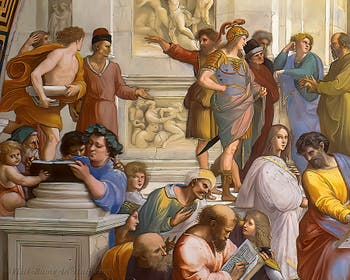
Raphael, School of Athens The Sophists were clever, manipulative speakers, and we can see that the first of them, the one who wears a headdress, stands up to the man who rejects them by trying to show him that he is wrong.
Under the Sophists, a man crowned with vine branch is writing in a book supported by a child.
It would be the philosopher Epicurus said that sensation is the first level of knowledge because it is a response to excitement coming from the world around us.
Perceived things are the objects on which the thought that observes, analyzes, verifies, etc., is exercised.
Epicurus had a cult of friendship: he had ensured a decent existence for the orphaned children of his friends and all the elders who had studied alongside him and helped him during his life.
He appears here under the guise of “Fedra”, whose real name is Tommaso Inghirami, a cultured and good man, famous as a poet and speaker, who was prefect of the Vatican Library.
Raphael painted another portrait of Inghirami, now in the Pitti Palace Gallery in Florence.
Pythagoras and the Science of Numbers
At the bottom left of the fresco, we can see Pythagoras representing mathematics.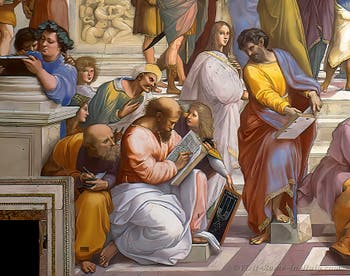
Raphael, School of Athens He is currently writing an explanation of a sketch drawn on a slate placed in front of him by a young boy.
It would be a sketch of a tuning fork indicating the numerical ratios that regulate the sounds.
Mathematics are emphasized here as the basis of musical harmony.
Recall that, according to Plato, the harmony of sounds, based on mathematical relationships, was comparable to the harmony of the celestial spheres.
Pythagoras would have been the first to teach his students how to write numbers on an abacus.
Note that the tuning fork only appears in the final Vatican fresco, while the slate is blank in the preparatory drawing of the School of Athens, located in Milan.
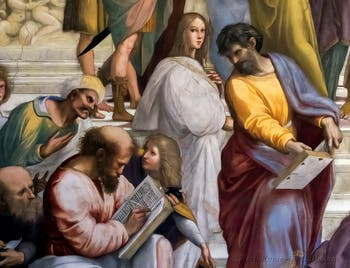
Raphael, School of Athens Sitting next to Pythagoras, an old man copies everything the mathematician writes.
We also notice a turbaned Oriental who bows behind him.
Some saw it as the physician-philosopher Avicenna, who presented a fusion of Platonism and Aristotelianism with Islamic thought.
For others, it would be Averroès, the Andalusian Muslim philosopher, theologian, jurist and physician.
In front of Pythagoras, a man wearing a yellow tunic under his coat shows him a book, one foot resting on a block of marble; it could be Empedocles or Parmenides.
Francesco Maria Della Rovere, Duke of Urbino and nephew of Julius II
When we saw that Raphael represented Francesco Maria Della Rovere, Julius II’s nephew, in his “School of Athens”, we thought it was flattery on his part.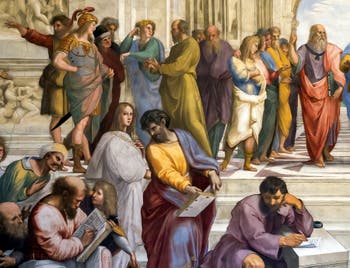
Raphael, School of Athens Francesco Maria Della Rovere is placed in a particularly advantageous way: standing halfway between Socrates and Pythagoras, the body draped in a white mantle lined with gold held by a delicate hand, with an angelic face turned towards the viewer.
Francesco Della Rovere was also Duke of Urbino, husband of Eleonora Gonzaga, and a friend of Raphael, this young man, passionate about philosophy and the arts, was in Rome when the fresco was made.
But since the discovery of a letter from Julius II in the Mantua archives, we now know that Julius II himself asked Raphael to represent his nephew among the philosophers of the School of Athens.
After all, since this fresco was intended to decorate the pope’s library, it is understandable that he would want to see the faces of people he liked there.
Michelangelo as Heraclitus in the School of Athens
Even if we have not found any writing concerning the presence of Michelangelo in the fresco, we think that, as for the pope’s nephew, Raphael must have added the philosopher Heraclitus in the guise of Michelangelo at the request of Julius II.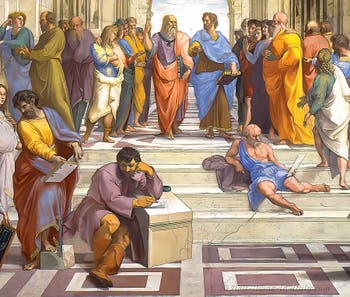
Raphael, School of Athens A character totally absent from Raphael’s preparatory work preserved at the Pinacoteca Ambrosiana in Milan, and for a good reason, the two artists did not like each other, Raphael having used all his connections to exclude Michelangelo from possible Vatican commissions and to become the leading artist at the papal court.
In defence of Raphael, a perfect court man, charming, affable, worldly, and pushy, Michelangelo was known to be a problematic, sour, and unbearable genius who did not mind ridiculing his competitors and rebuking anyone who could disturb him in his work.
In the preparatory box, apart from the presence of Diogenes, the staircase is empty from bottom to top as far as Plato, a way of drawing attention to the philosopher by highlighting him.
Therefore, it is easy to understand the positioning of Heraclitus in the fresco: it was the only free space of sufficient size.
In fact, it was a very last-minute addition because the mural was already finished and completely dry when Raphael had to place this new character on it.
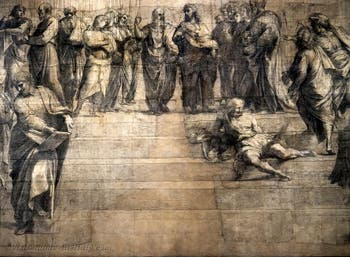
Raphael, School of Athens This was a significant technical difficulty because to do this: it was necessary to remove all of the lime plaster painted there to replace it with a fresh layer and paint it, with the risk of damaging the rest of the fresco.
It should be remembered thatwhen the fresco at the School of Athens was created, at Julius II’s request, Michelangelo was creating those on the ceiling of the Sistine Chapel.
Michelangelo is the only character in the fresco dressed as a Renaissance craftsman, with cuffed leather boots and a simple tunic with a large collar, which sets him apart and contrasts him with the other characters, who are all dressed in antique fashion.
Raphael would thus have found a way to satisfy the pope’s request to add his competitor while isolating him from the group of thinkers by placing him in a different time, working alone, away from the court, alien to the “sublime society” of others.
Raphael obeyed the orders of the pope but, at the same time, humiliated and belittled Michelangelo by not integrating him into the group of philosophers and mathematicians present.
The portrait is not flattering; it is almost a caricature: the character has no elegance, no outfit, almost slumped on his marble cube.
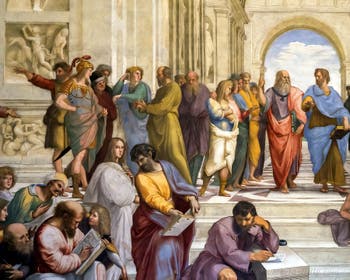
Raphael, School of Athens He is writing without even looking at the page, in a state of indifference similar to Diogenes reading two steps above him.
Unlike Diogenes’ tranquil pose, Michelangelo writes in a stocky, tense posture, that of a thinker focused on a complex problem.
The choice of presenting Michelangelo in the guise of Heraclitus is not at all trivial.
Heraclitus pretended to speak by listening to Nature alone. He was a formulaic worker who worked on the conciseness of his sentences, which should be as short as possible while having several possible meanings.
Like an artist, he wanted to overcome the oppositions and contradictions experienced by bringing them together without suppressing them.
For him, the One was above everything.
The Heraclitus cube is also present in Dürer’s “Melancholy I”, a symbol of Alchemical Opus similar to Plato’s cornerstone.
Heraclitus Michelangelo represents the man who is prey to the difficult task of conciliation, which consists of overcoming contradictions and antagonisms and integrating them to find balance in unity.
If all this was due to Raphael’s desire to humiliate his competitor in the scowling face of a solitary genius, the result is a success!
The Right Part of the School of Athens
Raphael
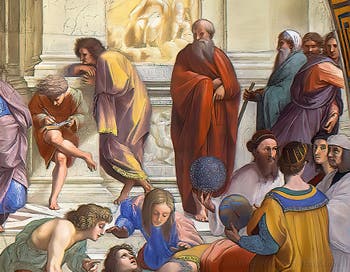
Raphael, School of Athens Raphael represented himself on the right side of the fresco.
It is easy to distinguish him at the bottom right because he looks at the viewer; he is one of the scarce characters in the painting to do so.
He thus signed his work twice, first by placing himself among philosophers and scientists, then by adding the gold letters “R.V.S.M.”, which he deliberately made barely legible on the Euclid Pass.
“R.V.S.M.” meaning Raphael Urbinas Sua Man: by Raphael.
Euclid (or Archimedes) and the Science of Forms
Euclid, the representative by excellence of the science of shapes and, therefore, of geometry, is leaning forward with a bald head and an orange-red coat, measuring with a compass a geometric figure comprising two triangles superimposed to form a six-pointed star in front of interested and admiring students.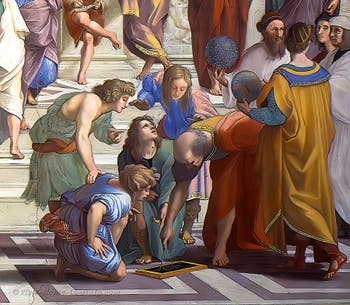
Raphael, School of Athens This geometric study was highlighted two years before the design of the Athens School by a mathematician-geometer named Luca Pacioli, who was also close to Leonardo da Vinci, in his essay “De Divina Proportione”.
Pacioli had reviewed and developed Euclid’s principles, thus designing numerous new solid geometric shapes.
A study in correlation with research on the golden ratio.
While thus paying tribute to Pacioli’s research, Raphael chose to give Euclid the features of his friend Donato Bramante, the architect of Saint Peter’s Basilica.
Bramante was particularly well introduced to the Vatican, and it was thanks to him Raphael was able to secure most of his orders at the papal court, hence this solid tribute for his friend and protector.
Ptolemy and Zoroaster
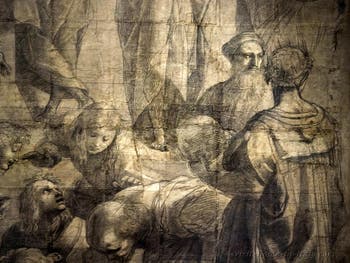
Raphael, School of Athens Behind Euclide-Bramante, we go from geometry to cosmology by seeing Ptolemy and Zoroaster... in the presence of Raphael, the young man with his face turned towards the spectator.
Seen from behind, the Greek astronomer Ptolemy holds a globe elegantly dressed in golden yellow, wearing the royal crown and magnificent sandals.
Its geocentric system (where the earth is at the centre of the Universe) was considered the only valid one by Renaissance theologians.
A system that responded entirely to the dogmas of the Church, hence the idea of awarding the crown to its author to assert its superiority over the heliocentric theories that were beginning to emerge.
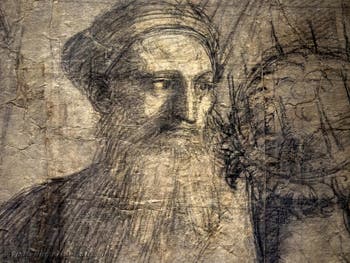
Raphael, School of Athens Indeed, while Raphael was finishing his School of Athens in 1511, Nicolas Copernicus began to write his famous treatise, the “De Hypothesibus Motuum Coelestium a se Contitutis Commentariolus”.
Opposite Ptolemy, Zoroaster dressed in white and wearing a strange hat, with his big eyes and oriental beard, rotates a starry celestial sphere at the tips of his fingers.
The great Iranian prophet perfectly represented the eastern astronomers of Antiquity who had already well observed and studied the movement of celestial bodies.
Above the group of astronomers is an older man with a long grey beard.
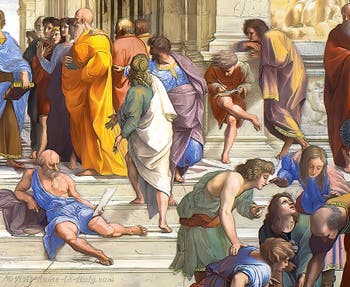
Raphael, School of Athens Some have seen a portrait of the painter Sodoma, who had participated in creating the fresco from original test boxes; others see the picture of Perugino, Perugino Raphael’s former master.
The hypothesis that this is Perugino seems the most probable given the age of the character, closer to that of Perugino than to that of Sodoma, who was only six years older than Raphael.
As for the young man who is writing while leaning on the wall, cross-legged and disheveled, we assume that he is a poet inspired by his genius.
All these scholars, artists, philosophers, who reflect, talk to each other, exchange, teach... the School of Athens represents the best of humanity, an ideal of civilization.
An ideal shared by Renaissance humanists.
Back to Page 1
Art Story Sistine Chapel | Raphael | Caravaggio | da Vinci | Giotto | Titian | Veronese | Sculptures | Van Gogh |
Vatican Art Story | Location | Opening Hours Tickets | Authorisations
Back to Top of Page

